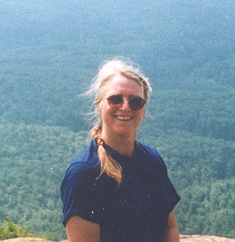Winter 2002  Page 12
Page 12
Carol Budd
Candidate for the Position of President-Elect
(elected by acclamation)
Hello to all my ABLE friends. I have been solicited to run for ABLE president. I couldn't be more enthusiastic at the prospect. In an effort to convey to you my background, I have put together the following informal biography to introduce myself to you more fully.

I graduated from St. Lawrence University (SLU), Canton, New York (fondly called the Klondike by natives) in 1977 with a major in biology and a definite determination NOT to teach. My mother always encouraged me to get some education courses in my repertoire. Upon graduation, I enrolled at the State University of New York College of Environmental Science and Forestry (SUNY ESF). SUNY ESF allowed me to investigate biochemical markers for determining regional populations of coyotes, Canis latrans, the then eastern enigma of the canid world. Coursework at the SUNY Medical School and Syracuse University opened up theoretical worlds I had never dreamed could be so exciting. Since then, the use of molecular techniques to answer population questions has been a favorite area of interest.
After finishing my M.S. I went to SLU's graduate education program to become certified to teach all four basic sciences in secondary school (mother really does know best). I then spent two years teaching the 9th grade General Science curriculum to 15 year olds waiting to turn 16 so that they could drop out. It was very challenging and forced me to adopt a pedagogy that I use to this day. I strongly believe and practice honesty with students about behaviors that impede or assist them in achieving their goals without passing judgement. I am clear in my expectations, make every effort to assist student achievement, and allow students to experience the results of their decisions. The class average of my first term was 24%. When I left, the class average was 64%. Many more students passed their exams than had I not applied the pedagogy (based on Carl Rogers PEGS). More importantly, there were more students more motivated to work. Hopefully, they learned something, if not about General Science, then about life.
In 1984, I was hired as the General Biology Laboratory Assistant by SLU. Although SLU is a small liberal arts and sciences college, the General Biology lecture was and remains the largest lecture course on campus. Converting the content-based environment into one more concerned with practicing and understanding the skills and content to answer a smaller range of questions utilizing scientific method was also challenging. In the early years, I wrote, prepped and presented labs and more recently, I lecture the team taught revised inquiry based course. We are assessing the transition to the inquiry based pedagogy from the content-based (fondly referred to as the firehose method) by tracking 10 years of students prior to the transition and 10 years from the inception of the new course. We have seven more years of data collection to go. I practice the same Rogerian PEGS developed in my secondary teaching experience and have a long SLU alum Christmas card list that I think addresses its efficacy.
I believe that I have been an ABLE member since 1985. Participation in the annual conference enabled me to integrate inquiry-based laboratories into our introductory biology lab curriculum. We still write our own manual that includes many adaptations of the tested ABLE labs. I have participated in ABLE membership duties as chair, co-chair and proceedings mailer for the past 15 years. At two different annual conferences, I presented a major and a mini workshop. ABLE work and friendships have been an integral part of my professional life.In addition to the above current tasks, I steward the million-dollar budget of the SLU's Integrated Science Education Initiative (ISEI). The ISEI initiative utilizes a 76-acre wetland campus property to collect data on watershed dynamics, biodiversity and paleo-ecology. The data is collated in a geo-spatially referenced Natural History Database. The database is available to students, faculty, community and governmental agencies to advance inquiry into questions generated by the data. In the current year, we have designed a field station, multiple boardwalks and renovation of an existing bridge and are in the process of submitting a joint application to the Army Corps of Engineers and the New York State Department of Environmental Conservation for these improvements to the wetland.
So, what do I do in my spare time? My spouse Tom and I have built by our own hands, a post-and-beam home in the rural Adirondack foothills/St. Lawrence River valley. It includes spacious garden plots and is a post-work haven.
Overall, I believe that I have the time management, organizational and interpersonal skills to represent ABLE in a constructive capacity. I would enjoy the opportunity to work with the current board to promote the objectives of ABLE. The chief components of ABLE to me include the annual and regional conferences; the membership; the construction and publication of the proceedings volume; and the dissemination of ABLE information through our web site, proceedings volumes and members. I feel that the current mechanisms are efficient in maintaining these vital ABLE components. I generally work with the motto, "If it's not broken, don't fix it". I would assist the ongoing efforts of those at the helm of these vital aspects in whatever capacity they need. I annually walk away from our conference with so many ideas that it usually takes me weeks to allow the ideas to settle. There is no shortage in our organization of ideas. This is the cauldron from which I will draw. Thank you for this opportunity to participate. I am honored.
![]()
ã 2002 ABLE. All rights reserved.